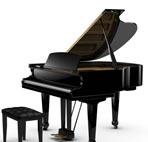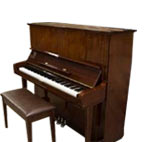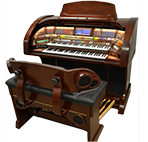Certain key elements are what all music is based on – melody, harmony, rhythm, and dynamics – that are essential in establishing the essence of music.
As with anything, there is an elemental basis for the composition of music. The material essence of music lies with its melody, harmony, rhythm, and dynamics. Melody gives music soul, while rhythm blends the expression of harmony and dynamics with the tempo of the passage. All are necessary to create a recognizable pattern known as a “song.”
Melody is a musical and successive line of single tones or pitches perceived as a unity. Its characteristics include range, shape, and movement. Each of these will be discussed separately.
Range — The range of a piece is the distance between the lowest and highest tones. Singers refer to an arrangement being in a low, medium, or high range, meaning that the notes focus on those scale pitches. A piece that has a narrow range is one in which the melody centers around a few given notes. In contrast, an arrangement calling for a wide range takes the musician from low to high pitches, often encompassing as many as fifteen whole steps on the scale.
Shape — Melody takes its own direction, or shape. When musicians talk about the shape of a melody line, they are referring to the literal geometric line that could be made if the notes were joined together as in a dot-to-dot puzzle. Notes that ascend up the scale take on an upward shape, while phrases that descend are shaped in a downward motion. If the phrase stays within a narrow range, the shape is wavelike.
Movement — Movement can be either conjunct or disjunct. When the melody moves stepwise and is connected, the movement is termed conjunct. Melody that leaps from pitch to pitch with no natural connection or flow is said to be disjunct.
Melody is structured by its length and intensity much like sentences in a spoken language. For instance, a phrase in music is a unit of meaning within the larger structure of the song in its entirety. Other examples include the cadence and the climax. A cadence is a final ending to a musical section. A climax is a high point of intensity.
Harmony is the relation of notes to notes and chords to chords as they are played simultaneously. Harmonic “patterns” are established from notes and chords in successive order. Melodic intervals are those that are linear and occur in sequence, while harmonic intervals are sounded at the same time. Whether or not a harmony is pleasing is a matter of personal taste, as there are consonant and dissonant harmonies, both of which are pleasing to the ears of some and not others.
Chords have meaning as they lead to other chords. Certain progressions are encouraged as acceptable in certain styles of music. But basic to all harmony – regardless of style – is the triad. A triad is the most common chord form. It is built on the first, third, and fifth notes of the scale – do, mi, and so – and is symbolized in musical notation by the Roman numeral I. A triad built on the second note of the scale would include the second, fourth, and sixth notes of the scale, still keeping one scale degree between each jump. A triad built on the second note of the scale is written as ii. Triad chords may be built on all seven notes of the scale (with the eighth note a repeat of the first.) Chord symbols for the triads built on the third through seventh notes of the scale are as follows: iii, IV, V, vi, and vii. The I chord is named the Tonic, and the IV chord is called by the name Sub-Dominant. The V chord is the dominant. The vii is referred to as the Leading Tone, as it is often used to change (or “lead”) into a new key. This organization around tones is known as “tonality.”
Rhythm is, by its simplest definition, musical time. The origin of the word is Greek, meaning “flow.” Rhythm is indeed the embodiment of timely flow. As meter regulates and pulsates a poem, rhythm organizes music in much the same way. The regular pulsations of the music are called the beat. Stronger beats are referred to as “accented” beats. Measures of music divide a piece into time-counted segments. Strong beats occur in patterns. For instance, in 4/4 time, the conductor would beat a strong beat on the first beat of every measure and another accented beat – although not as strong – on the third count of the measure. Because the conductor’s arms move downward on strong beats, especially those that begin a measure, accented beats are also referred to as “downbeats.”
Time patterns in music are referred to in terms of meter. Two beats to a measure is duple meter, while the three beat measures of a waltz indicate triple meter. Four beats to a measure is known as common time, or quadruple time. Six beats to a measure is representative of time that can be divided by three, such as six beats to a measure with accented beats on the first and fourth beats. When the melody falls on notes that occur between beats, it said to be syncopated time.
Along with rhythm comes the idea of rate or pace. Not every song is slow. Neither is every song fast. Tempo is the musical term that indicates the overall pace of an arrangement. Tempo markings include grave, meaning solemn and extremely slow or allegro, meaning fast and cheerful. A gamut of musical terms for rhythm exists.
Once a song is organized by melody, harmony, and rhythm, it is technically presentable. Although some indication of mood is expressed through the tempo at which a piece is meant to be played, without dynamics, music lacks the emotion behind the musical thought. Dynamics tell the performer when to play loudly or more softly and when to change from one to the other. From pianissimo (as soft as you can play) to fortissimo (the loudest you can play), music ranges from a whisper to the fullest of sound.
Hence, the composer utilizes the tools of composition for the intimacies of musical expression – melody, harmony, rhythm, and dynamics – all a part of what we know simply as a “song.”










